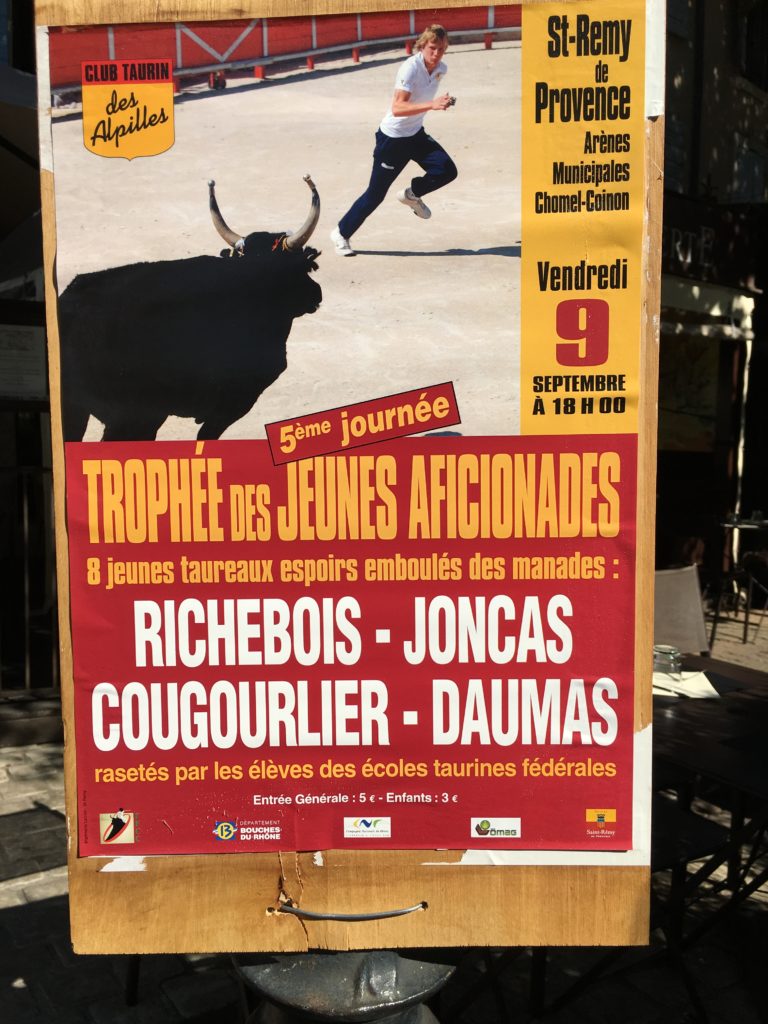The injury to my hand, coupled with a bad reaction to the ibuprofen and naproxen I took to manage the pain, did a number on the last two days in St. Rémy-De-Provence. However, we were able to do some interesting things.
Friday we walked to the Roman ruins of Glanum, about a mile from our hotel. It was a very warm day. Neither of us thought to fill up our water bottles, let alone bring them. As a result, Julian was one sorry specimen. Fortunately, the souvenir shop at the ruins had a vending machine full of Evians. Dinner that night, once we tidied up, was at a restaurant called L’Estagnol. Word from these wise guys: There is nothing better on a hot day than a cold bowl of gazpacho made with dead-ripe tomatoes. It also helped that the dessert we chose was a cold peach soup with a little scoop of vanilla ice cream. The main course was braised pork ribs – excellent, but my stomach couldn’t handle much of it.
At any time of the day or night in Provence, you will hear the clack of metal balls. This is pétanque, or boules. Les Provençaux take this game very seriously. Most villages have flat, sandy areas called boulodromes for this game. Even non-designated boulodromes are pressed into service, as long as the surface is flat.
One event we did not witness is what Julian refers to as “the taunting of the bulls.” This is more like American rodeo clowns than traditional bullfights. Young men with more testosterone than common sense get into a ring with a bull and attempt to grab a ribbon off the bull’s horn. The bull wants no part of this and chases the man. With luck, the guy jumps over a barrier or onto bales of straw to escape. If luck is not with the man, bad things can happen. Unlike traditional Spanish bullfighting, the bull lives to be taunted another day. Some of these bulls develop national reputations. As far as the bull-taunters go, one hopes they have day jobs.

Poster for bull-taunting.
St. Rémy has an organ festival every year at the St. Martin church. They invite renowned musicians from all over France to play the 170-year-old pipe organ. Some of the concerts include choirs and orchestras. The organist at our concert, Olivier Trachier, was from a familiar church – St. Gervais in Paris. He may have been the organist playing and practicing the two times we visited Paris. Since the organ is directly opposite the altar and the organist is hidden from view, the church set up a screen and projected live video of Trachier at the keyboard. Periodically the camera would cut to his feet if the piece of music required him to use those keys. The concert consisted of three centuries of French organ music. Organ pieces are usually short. It may have been designed to give the poor souls who worked the bellows to provide the air to the pipes a chance to rest. (Most of the European organs predate electricity by a couple hundred years.)
From St. Rémy it was on to Les Gorges du Verdon. St. Rémy is positively cosmopolitan compared to the little towns here. More to come.

Recent Comments